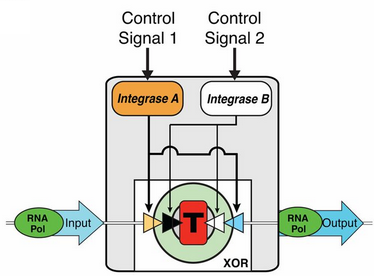Stanford University bioengineers have taken computing beyond mechanics and electronics into the living realm of biology by creating the “transcriptor” — a biological transistor made from DNA and RNA.
In electronics, a transistor controls the flow of electrons along a circuit. Similarly, a transcriptor controls the flow of a specific protein, RNA polymerase, as it travels along a strand of DNA.
“Transcriptors are the key component behind amplifying genetic logic — akin to the transistor and electronics,” said Jerome Bonnet, PhD, a postdoctoral scholar in bioengineering and the paper’s lead author.
The transcriptor now allows engineers to compute inside living cells — to record, for instance, when cells have been exposed to certain external stimuli or environmental factors, or even to turn on and off cell reproduction as needed.
“Biological computers can be used to study and reprogram living systems, monitor environments and improve cellular therapeutics,” said Drew Endy, PhD, assistant professor of bioengineering and the paper’s senior author.
The biological computer
[+]

The logic element within a three-terminal Boolean integrase EXCLUSIVE OR (XOR) gate such that gate output is high only if control signals are different (credit: Bonnet et al./Science)
“We have repurposed a group of natural proteins, called integrases, to realize digital control over the flow of RNA polymerase along DNA, which in turn allowed us to engineer amplifying genetic logic,” said Endy.
Using transcriptors, the team has created the equivalent of logic gates that can derive true-false answers to virtually any biochemical question that might be posed within a cell.
They refer to their transcriptor-based logic gates as “Boolean Integrase Logic,” or “BIL gates” for short.
Despite their outward differences, all modern computers share three basic functions: storing, transmitting and performing logical operations on information.
Transcriptor-based gates alone do not constitute a computer, but they are the third and final component of a biological computer that could operate within individual living cells. Last year, Endy and his team made news in delivering the other two core components of a fully functional genetic computer: a rewritable digital data storage within DNA, and a mechanism for transmitting genetic information from cell to cell, a sort of biological Internet.
It all adds up to creating a computer inside a living cell.
Boole’s gold
In a biological setting, the possibilities for logic are as limitless as in electronics, Bonnet explained. “You could test whether a given cell had been exposed to any number of external stimuli — the presence of glucose and caffeine, for instance. BIL gates would allow you to make that determination and to store that information so you could easily identify those which had been exposed and which had not,” he said.
Or you could tell the cell to start or stop reproducing if certain factors were present. And, by coupling BIL gates with the team’s biological Internet, it is possible to communicate genetic information from cell to cell to orchestrate the behavior of a group of cells.
Biological versions of all of the basic logic gates — AND, NAND, OR, XOR, NOR, and XNOR gates — can be constructed.
How to build a transcriptor
To create transcriptors and logic gates, the team used carefully calibrated combinations of enzymes — the integrases mentioned earlier — that control the flow of RNA polymerase along strands of DNA. If this were electronics, DNA is the wire and RNA polymerase is the electron.
“The choice of enzymes is important,” Bonnet said. “We have been careful to select enzymes that function in bacteria, fungi, plants and animals, so that bio-computers can be engineered within a variety of organisms.”
On the technical side, the transcriptor achieves a key similarity between the biological transistor and its semiconducting cousin: signal amplification.
With transcriptors, a very small change in the expression of an integrase can create a very large change in the expression of any two other genes.
To understand the importance of amplification, consider that the transistor was first conceived as a way to replace expensive, inefficient and unreliable vacuum tubes in the amplification of telephone signals for transcontinental phone calls. Electrical signals traveling along wires get weaker the farther they travel, but if you put an amplifier every so often along the way, you can relay the signal across a great distance. The same would hold in biological systems as signals get transmitted among a group of cells.
Public-domain biotechnology
To bring the age of the biological computer to a much speedier reality, Endy and his team have contributed all of BIL gates to the public domain via the BioBrick Public Agreement so that others can immediately harness and improve upon the tools.
“Most of biotechnology has not yet been imagined, let alone made true. By freely sharing important basic tools everyone can work better together,” Bonnet said.
The research was funded by the National Science Foundation and the Townshend Lamarre Foundation.

No comments:
Post a Comment